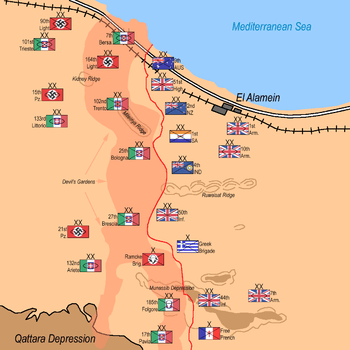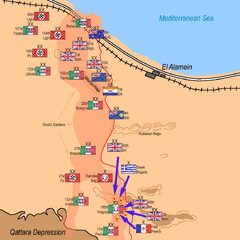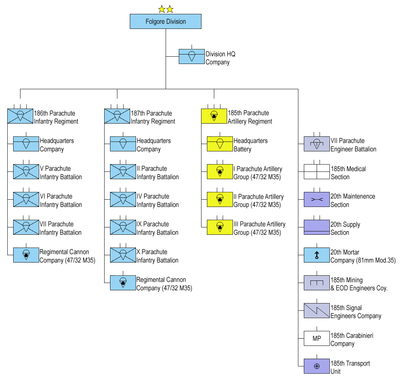185th Airborne Division Folgore
| 185th Airborne Division Folgore | |
|---|---|
|
Folgore Division Insignia | |
| Active | 1 September 1941– 23 November 1942 |
| Country | Italy |
| Branch | Italian Army |
| Type | Infantry |
| Role | Parachute |
| Size | Division |
| Nickname | Folgore |
| Engagements | World War II |
185th Airborne Division Folgore or 185ª Divisione Paracadutisti Folgore was a Parachute Division of the Italian Army (in Italian Regio Esercito) during World War II.
History
The division was formed on 1 September 1941 in Tarquinia, as the 1ª Divisione Paracadutisti. The division was intended to be used in Operation Hercules - the planned Axis invasion of Malta. Initially the division was made up of the following units:
- Division headquarters and headquarters company
- 1st Parachute Infantry Regiment (later renamed 185th Parachute Infantry Regiment)
- Headquarters and Headquarters Company
- II Parachute Infantry Battalion
- III Parachute Infantry Battalion
- IV Parachute Infantry Battalion
- 1st Regimental Cannon Company (with 47/32 M35 antitank guns, nicknamed elefantino - little elephant, for his shape)
- 2nd Parachute Infantry Regiment (later renamed 186th Parachute Infantry Regiment)
- Headquarters and Headquarters Company
- V Parachute Infantry Battalion
- VI Parachute Infantry Battalion
- VII Parachute Infantry Battalion
- 2nd Regimental Cannon Company (with 47/32 M35 antitank guns)
- 3rd Parachute Infantry Regiment joined the division on 3 March 1942 (later renamed 187th Parachute Infantry Regiment)
- Headquarters and Headquarters Company
- IX Parachute Infantry Battalion
- X Parachute Infantry Battalion
- XI Parachute Infantry Battalion
- 3rd Regimental Cannon Company (with 47/32 M35 cannons)
- Parachute Artillery Regiment (later renamed 185th Parachute Artillery Regiment)
- Headquarters and Headquarters Battery
- I Parachute Artillery Group (with 47/32 M35 cannons)
- II Parachute Artillery Group (with 47/32 M35 cannons)
- III Parachute Artillery Group (with 47/32 M35 cannons)
- VIII Parachute Engineer Battalion
- Mining and Explosives Engineers Company
- Signal Engineers Company
- Division Service Units
Each Parachute Infantry Battalion fielded one Headquarters and three Parachute Infantry Companies. Each Parachute Artillery Group fielded one Headquarters and two Parachute Artillery Batteries armed with 47/32 M35 cannons. The VIII Parachute Engineer Battalion fielded one Headquarters and three Parachute Engineer Companies.
The Division was well equipped with modern automatic weapons (Beretta submachine gun, Breda M37 and Breda M38 heavy machine guns) and many support weapons, giving the paratroopers of the division a good firepower against infantry and light tanks, but without any transports or medium and heavy artillery. After the cancellation of the invasion of Malta the division was sent to the North African theater. However it left the 1st Parachute Infantry Regiment with one battalion in Italy as foundation for the 184th Airborne Division Nembo. On 30 April 1940, the 2nd Paratroop Battalion received their baptism of fire when the 5th and 6th Companies of Captains Avogadro and Macchiato dropped on Zante, Cephalonia and San Mauro, capturing the Greek islands and the 250-strong garrison.
In June 1942 the divisions name was changed to 185th Airborne Division Folgore and its regiments renumbered and renamed as well. In North Africa the division participated in the Battles of El Alamein, where the division was the protagonist of a strong resistance against the attacking Commonwealth forces, managing also to drive off some attacks conducted by tanks and heavy infantry. In the course of the Second Battle of El Alamein the division was completely destroyed.
El Alamein
During the Second battle of El Alamein the Folgore Division was under attack from three British divisions 44th (Home Counties) Infantry Division, 50th (Northumbrian) Infantry Division, 7th Armoured Division, and the 1st Free French Brigade.[1][2]
As a preliminary, the British 131st (Queen's) Brigade supported by tanks from the 4th Armoured Brigade launched Operation Braganza attacking the Folgore on the night of 29–30 September in an attempt to capture the Deir el Munassib area. But the Italian paratroopers repelled the attack, killing or capturing over 300 attackers.[3] It was wrongly thought that ‘German paratroopers’ had manned the defences. The Afrika Korps's war diary notes that the Italian paratroopers "bore the brunt of the attack. It fought well and inflicted heavy losses on the enemy."[4]
Operation Lightfoot launched on 24 October 1942, was designed to break through the supposed "weak" Italian-held southern sector of the Alamein line where the Bologna, Brescia, Pavia and Folgore Divisions anchored the right flank. The Italians are reported to have fought very well on 24 October:
"The Ariete Division, the Bersaglieri Battalion and units of the Brescia and Folgore Divisions fought magnificently. Montgomery's 13th Corps was able to make minor break throughs in the eastern minefield, but did not reach the main front line."[5]
The British attack began with an artillery barrage, followed by an all out assault by the 7th Armoured and 44th Infantry divisions. However, all that was achieved at a high cost of life and equipment was a small salient, which was soon recaptured by the Folgore.
In the following days between 25 October and 4 November, the 50th, 7th, 44th divisions, 1st and 2nd Free French and the Royal Hellenic Brigades, supported by artillery and armour, failed to break through in the southern sector.
The Folgore used everything at their disposal including letting the enemy advance into a "cul-de-sac" and then launching a counterattack from all sides.
They also used their 47mm Anti-tank guns from enfilade positions and Molotov cocktails to knock out the advancing tanks.[6]
In the Second Battle of Alamein, the Folgore is reported to had destroyed over 120 armoured vehicles, and inflicted over 600 casualties and captured 260 Allied soldiers.[7]
On 6 November, after having exhausted all its ammunition, the remainder of the Division surrendered.
The few survivors, who managed to withdraw, were reorganized into the 285 Folgore Parachute Battalion and fought in Tunisia, they surrendered to the British in 1943, but without having to show a white flag and without having to raise their hands while surrendering.[1][2][8]
Battle analysis


At El-Alamein, throughout several engagements, the paratroopers were either able to drive back the attacks or, when the enemy had been successful in completely wiping out the first line of outposts, to reform again, usually counterattacking. In spite of the overwhelming numbers, the British made little headway against them, and in the end, the Folgore was ordered to fall back because the enemy obtained a breakthrough elsewhere.
The reasons behind this limited victory of sorts are two: mines and "guts". The mines were of course an invaluable asset for the defense. Here the minefields were extensive, thick, and treacherous; furthermore, the mines were in multiple fields. They forced the attackers to move slowly and to stick to the bottlenecks of the cleared pathways, often under observed artillery fire. Whenever the exit of the cleared track was within reach of one of the short-ranged Italian 47mm AT guns, it was easy to block the attack, provided that the first tank or two were disabled.
But the British had effective mine-clearing task forces, flail tanks (the Scorpions) and Valentine tanks, and heavy artillery barrages to move behind. All of their main attacks, in the end, came through the minefields. There, the outnumbered paratroops, after hours of artillery fire, counterattacked the infantry and close assaulted the tanks, with grenades and molotov cocktails. Notwithstanding the heavy casualties they suffered, and temporary British successes in occupying several positions in the first outpost line, they held their ground.
The main British effort, of course, was in the northern part of the line of the "Battle of El Alamein". However, the four divisions attacking the Folgore positions in the south, had also been given breakthrough objectives, that they did not reach. The 7th Armoured Division had been ordered to spare their tanks, so their attacks were called off after the bloody fighting during the night of October 24: 31 British tanks were destroyed or disabled during that night alone.[9]
At the end of the battle of El Alamein, Harry Zinder of Time magazine noted that the Italians paratroopers fought better than had been expected, and commented that: In the south, the famed Folgore parachute division fought to the last round of ammunition.[10]
With a few survivors and some replacement, the 285º Battaglione Paracadutisti "Folgore", a battaillon-size unit commandeered by captain Lombardini, was formed, and participated to the defense of the Mareth Line in Tunisia in mid 1943, particularly at the battle of Takrouna, where it was completely destroyed, but not before it mounted a determined counterattack that prolonged the fighting.[11]
The New Zealand Official History claims that the 47th and 104th Panzer Grenadier Regiments were the real reason behind the determined defence of Takrouna that cost the 5th New Zealand Brigade 34 killed and 425 wounded and that 568 Italians and 164 Germans were captured.[12] However the authors of Italian Soldier in North Africa 1941-43 claim that 318 Italians and 5 Germans were captured.[13] The 2nd New Zealand Division newspaper during the war reported that 18 officers and nearly 400 other ranks were captured,[14] and an Allied war correspondent reported that 326 defenders had been captured and that the Italians had fought hard:
The fight atop the 600-foot peak finally ended at 8 p.m. last night. At that hour the first real Italian defenders the British had met surrendered in a body, 326 of them. They gave up only because their ammunition gave out. These Italians were tough, trained killers who didn't feel faint when stout British troopers flung their comrades over the cliffs to clear the road up the side of the steep peak and reach the village atop it. They stood, fired and fought back and when they gave up they said the allies wouldn't get to Tunis. They holed up in caves and crevices of the slopes and had to be dragged out before their machine guns and mortars were silenced. [15]
Order of battle

The division was sent to Africa and fought in the Battle of El Alamein with the following structure:[16]
- Division Headquarters and Headquarters Company
- 186th Parachute Infantry Regiment
- Headquarter and Headquarters Company
- V Parachute Infantry Battalion
- VI Parachute Infantry Battalion
- VII Parachute Infantry Battalion
- Regimental Cannon Company (with 47/32 M35 cannons)
- 187th Parachute Infantry Regiment
- Headquarters and Headquarters Company
- II Parachute Infantry Battalion (from 185th Parachute Infantry Regiment)
- IV Parachute Infantry Battalion (from 185th Parachute Infantry Regiment)
- IX Parachute Infantry Battalion
- X Parachute Infantry Battalion
- Regimental Cannon Company (with 47/32 M35 cannons)
- 185th Parachute Artillery Regiment
- Headquarters and Headquarters Battery
- I Parachute Artillery Group (with two batteries of 47/32 M35 cannons)
- II Parachute Artillery Group (with two batteries of 47/32 M35 cannons)
- III Parachute Artillery Group (with two batteries of 47/32 M35 cannons)
- VIII Parachute Engineer Battalion
- 185th Medical Section
- 20th Maintenance Section
- 20th Supply Section
- 20th Mortar Company (81mm Model 35 mortars)
- 185th Mining and Explosives Engineers Company
- 185th Signal Engineers Company
- 185th Mixed Carabinieri Company
- 185th Transportation Unit
- 260th Field Post Office
Honours
For its conduct during the Second Battle of El Alamein the divisions as whole was awarded a Gold Medal of Military Valor. The 185th Artillery, 186th Paratroopers and 187th Paratroopers regiments received a second Gold Medal for specific actions during the Second Battle of El Alamein. Additionally the following soldiers of the division were awarded a Gold Medal of Military Valor during the Western Desert Campaign:
- Second Battle of El Alamein:
- Corporal Major Antonio ANDRIOLO, 186th Parachute Regiment, October 23 – November 4, 1942
- First Lieutenant Roberto BANDINI, 186th Parachute Regiment, October 23–25, 1942
- First Lieutenant Ferruccio BRANDI, 187th Parachute Regiment, October 24, 1942
- Second Lieutenant Pietro BRUNO 132d Transport Regiment
- Private Giuseppe CAPPELLETTO, 186th Parachute Regiment, October 23–25, 1942
- Private Giacomo CESARONI, 187th Parachute Regiment, October 29, 1942
- Private Leandro FRANCHI, 186th Parachute Regiment, November 1942
- Second Lieutenant Giovanni GAMBAUDO, 186th Parachute Regiment, October 23–24, 1942
- First Lieutenant Marco GOLA, 186th Parachute Regiment, October 23–24, 1942
- Private Gerardo LUSTRISSIMI, 186th Parachute Regiment, October 23–25, 1942
- Sergeant Major Dario PIRLONE, 185th Artillery Regiment, October 24, 1942
- Sergeant Nicola PISTILLO, 186th Parachute Regiment, October 23–25, 1942
- Corporal Major Dario PONZECCHI, 185th Parachute Regiment, October 26, 1942
- Captain Costantino RUSPOLI, Prince of Poggio Suasa, 187th Parachute Regiment, October 26–27, 1942
- Captain Gastone SIMONI, 187th Parachute Regiment, October 23–27, 1942
- For other battles during the Western Desert Campaign:
- Sergeant Major Mario GIARETTO, 186th Parachute Regiment, August 8, 1942
- Second Lieutenant Omero LUCCHI, Folgore Division Artillery, August 31 – September 4, 1942
- Sapper Clinio MISSERVILLE, 185th Assault Sapper Company, September 10, 1942
- Major Aurelio ROSSI, 187th Parachute Regiment, August 20 – September 3, 1942
- Captain Fabio RUGIADI, 187th Parachute Regiment, August 30, 1942
- Lieutenant Colonel Luigi PASCUCCI 132d Transport Regiment
- Lieutenant Colonel Carlo Marescotti RUSPOLI, Prince of Poggio Suasa, 186th Parachute Regiment
- First Lieutenant Giovanni STARACE, Folgore Division, July - November, 1942
- Second Lieutenant Giovanni STASSI, 186th Parachute Regiment, August 25 – September 2, 1942
Folgore Combat Group
On 25 September 1944 the Italian Co-Belligerent Army raised the Folgore Combat Group with soldiers and materiel from the disbanded 184th Airborne Division Nembo. After the war the combat group became the Folgore Mechanized Division, which was disbanded on 31 October 1986.
Folgore Parachute Brigade
On 1 January 1963 the Italian Army raised the Folgore Parachute Brigade in Pisa. After the end of the Cold War the Italian Army decided to rename the battalions in its brigades as regiments for historical reasons. Therefore the battalions in the Folgore Parachute Brigade were given the names of the regiments of the former 185th Airborne Division Folgore.
See also
References
- ↑ 1.0 1.1 Wendal, Marcus. "Italian Army". Axis History. Archived from the original on 2009-05-03. Retrieved 2009-05-04.
- ↑ 2.0 2.1 Bennighof, Mike (2008). "185 Airborne Division". Avalanche Press. Archived from the original on 2009-05-03. Retrieved 2009-05-04.
- ↑ "At 05.25 hours the barrage fired by nine regiments of field artillery crashed down in support of the advancing infantry. The 1/6th Queen's advanced along the northern lip of the depression and met with little opposition. Similarly the 1/7th Queen's encountered no difficulty in taking the eastern edge of Munassib. However, its sister battalion, the 1/5th Queen's, had the more difficult task of seizing the southern lip of the depression. When its C Company approached the minefield in front of the enemy positions, the defenders, drawn from the Folgore Parachute Division, put down heavy mortar and machine-gun fire which pinned the troops to the ground. Meanwhile, A Company penetrated the Italian positions only to find itself surrounded and overwhelmed. The reserve companies were then held up by fierce defensive fire and made little progress. After day of heavy shelling, the 1/5th Queen's were withdrawn from their exposed posts. The operation cost the brigade 328 casualties for little gain." Pendulum of War: Three Battles at El Alamein, Niall Barr, p. 269, Random House, 2005
- ↑ Afrika Korps War Diary, 30 September 1942
- ↑ The Foxes of the Desert, Paul Carell, p. 279, Bantam Books, 1962
- ↑ "American Historian Praises The Role Of The Folgore In North Africa". Archived from the original on 2009-09-30. Retrieved 2009-09-26.
- ↑ "Solo sul fronte del 187° furono da lui raccolti circa 300 morti e catturati 260 prigionieri, fra i quali 12 ufficiali."El Alamein: immagini, cronache, testimonianze, Antonello Santoponte, p. 79, Settimo sigillo, 2005
- ↑ Quarrie, p 58
- ↑ Playfair I.S.O.(2004) [1st. pub. HMSO 1966], The Mediterranean and Middle East, Volume IV: The Destruction of the Axis Forces in Africa. History of the Second World War; United Kingdom Military Series. Uckfield, UK: Naval & Military Press, p.46
- ↑ Harry Zinder's nov 16, 1942 report for TIME MAGAZINE
- ↑ An Italian view of the battle for Takrouna
- ↑ New Zealand Electronic Text Collection
- ↑ "Eventually the New Zealanders succeeded in taking control of Takrouna, although their advance was in fact halted; 5th Brigade losses in this particular struggle numbered 459. At Takrouna 318 Italian and five German prisoners were taken." Italian Soldier in North Africa 1941-43, Pier Paolo Battistelli, Piero Crociani, Steve Noon, p. 53 Osprey Publishing, 2013
- ↑ "Thus, the amazing battle for Takrouna ended ... this important high point with its 18 officers and nearly 400 men was captured." NZEF Times, 3 May 1943
- ↑ British and Italians Battle To Death on Top Bloody Peak
- ↑ G.Lunardi, P.Compagni "I paracadutisti Italiani 1937/45", Editrice Militare Italiana, Milano 1989, pag.41
- Quarrie, Bruce; Anderson, Duncan (2005). German Airborne Divisions: Mediterranean Theatre 1942 - 1945. Osprey Publishing. ISBN 1-84176-828-6.
Further reading
- George F. Nafziger. Italian Order of Battle: An organizational history of the Italian Army in World War II (3 vol)
- Irving, David. La pista della volpe Mondadori editore. Milano, 1978
- Krieg, E. La guerra nel deserto - vol. 2 - La battaglia di El Alamein. Edizioni di Crémille. Ginevra, 1969
- Petacco, Arrigo. L'armata nel deserto. (Capitolo: Folgore). Mondadori editore. Milano, 2001
- Parachute landing troops on Kefalonia. (PL) .

